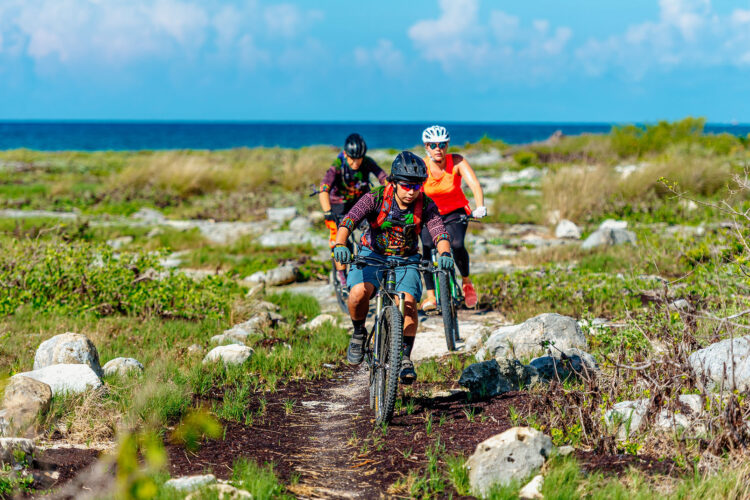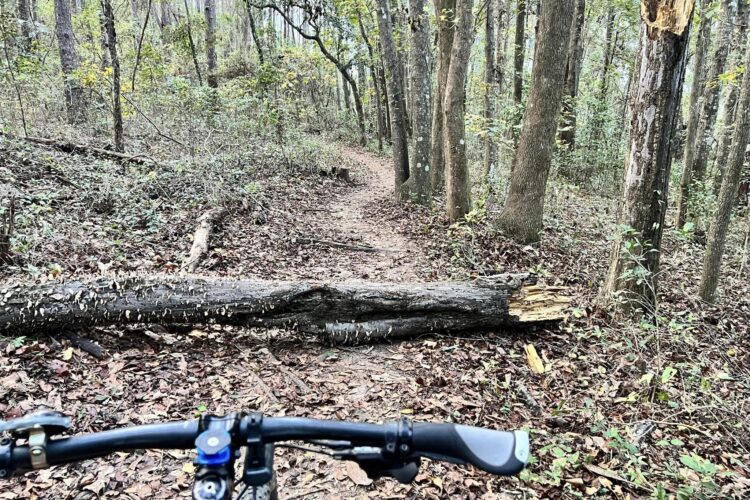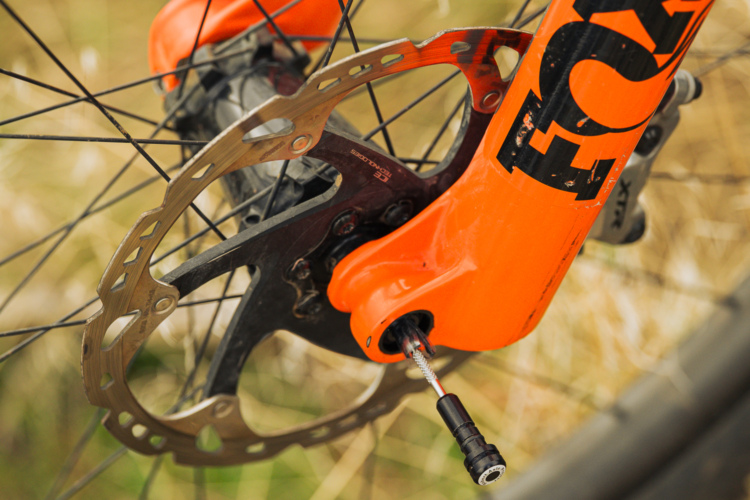
It’s the first day on the dig site at the Ixtepeji Bike Park, a growing mountain bike hot spot in Mexico, one hour from Oaxaca, the growing international foodie destination. After having flown over the entirety of the U.S. from their home in Bellingham, Washington, Spencer Baldwin and Scotty Scamehorn of the Shire Built trail building company, along with their associate Steven Vogel, are standing around the rented excavator, with the engine bay exposed and hydraulic fluid dripping from their finger tips. They look flummoxed and frustrated.
They’ve made a bit of progress on the first of two potential trails—about 20 yards—but not nearly as much as they’d hoped and now they’re halfway through the first of four days to dig.

“It’s like if you went on a trip and someone gave you a computer with a foreign keyboard,” Tony Martin says to me. The controls on the rented excavator are flipped, and it’s taking twice as long for Baldwin to dig, who is usually an ace on the machine.
Martin leads the guide company 2Wheel Epix, with tours in South and Central America, including Oaxaca. There are old and new trails running down the peak of the Ixtepeji Ecotourism Park. They’re mostly raw and rugged natural singletrack, splitting ferns below towering pines, and they’re a blast. But, they’re completely different than the trails Shire Built have created, which have elevated the brand’s reputation for dreamy, swoopy jump trails, highlighted in collaborative video edits with athletes and beloved by the Bellingham mountain bike community.
This is the first time in history the community-owned Ixtepeji ecotourism park has approved of a project like this and it could be a major turning point for mountain biking in Oaxaca, Martin told me.

“It’s a huge deal,” Martin said. “The fact that they’re letting us do this, it’s an opportunity for the international mountain bike community to step forward and show the people that we do care about these communities. And if you don’t do a good job and what you promised, then they’re not going to trust anybody else again.”
Martin’s guided trips are rooted in cultural exploration and giving back to the local communities in the biggest way possible. The new flow trail is an investment, and done correctly will pique interest in the Ixtepeji as a riding destination and increase interest in his guided trips.
But it’s also an opportunity to take three accomplished trail builders and have them instruct the dozen or more local mountain bikers and trail builders who live in Ixtepeji and Oaxaca, and the small surrounding villages on how to build a sustainable mountain bike trail, and give them a new benchmark; a progressive jump trail.
Scamehorn threads the hoses back on and cinches them tight. He isn’t positive that switching the two will work, but he’s optimistic. Baldwin starts the excavator and it roars to life. He pulls the levers, and though the excavator is rattly, hot, and underpowered, the controls are now “normal” and he starts carving into the next berm with sunset on his heels.
Finding the right zone

There are a few goals for the project, but they’re largely dependent on finding the right spot. Initially, the park wanted a very basic kids skill zone with a pump track and rollers, a beginner/intermediate jump line, and an advanced jump line. In reality, accomplishing all three is a matter of having the excavator in the right place.
The day before, we scouted three different locations with the leaders of the Ixtepeji Ecotourism Park. The second was the most appealing, with other trails feeding into what could be a jump line, but it was halfway across the park and would take the better part of a day to drive the excavator to it. The third location held two blank canvases; one for both an intermediate and an advanced jump line. It was also where the rental company dropped the excavator off. Off the bat, it might not have had the most sex appeal, but it was situated on the way into the park and between trails above and below.
The park is a community-owned entity, driving interest and a tourism-based economy for the Ixtepeji community. The appointed leaders of the park are Julian Leon Perez, known as Don Julian, and Epifanio Joaquin. Before running the park, Joaquin was a woodworker and Perez was a chauffeur.

Community members rotate occupations every few years and both were appointed a year-and-a-half ago to run the park. A paper mill once operated in the area and the mountain still sees logging, but the community has shifted with an eye toward mountain biking, hiking, birdwatching and other recreational activities. There are over 60 different tour operators who bring visitors to the park, Joaquin and Perez estimate. When people buy a ticket to enter the park, the money benefits the community as a whole, including the schools and the roads.
“To be honest, now that we are involved in this, we see it as something really good for the community in general, because one way or another, what we are looking for is to generate economic benefits for the community. For everybody.” said Perez. “And we see that this has a lot of future and above everything the forest is being preserved. Before, the work of Ixtepeji was to cut the trees down. Now with the ecotourism, we are trying to preserve them.”
About 80% of the visitors to the park are domestic visitors, from Oaxaca and other Mexican states and the other 20% are international. Mountain biking has grown steadily. Many of the trails around the Sierra Norte, including those rideable at the Ixtepeji Bike Park are ancient trails and were used by indigenous cultures like the Zapotec and Mixtec for agriculture and migration. They’re hoping the new professionally built trail will bring more people to the park.

When Perez and Joaquin’s three-year terms are up in another 18 months, they aren’t sure who will take the helm, but they’ll step down into another profession. They plan to stay involved as board members of the park.
On a roll

At the end of the second day, Scamehorn, Baldwin, Vogel, and the crew of a dozen local diggers put the finishing touches on the first beginner line. Shire Built took a blank hillside and painted a smooth ribbon of dirt that builds flow and speed before throwing riders in and out of a berm and into a series of three tabletops. The jumps feel natural—not too lippy and not too flat—and before long, the local riders and diggers are lining up in trains and hollering through the air. The locals are ecstatic, including Joaquin and Perez.
On the third day, they start on the advanced line using a space which was formerly a service road for the paper mill. They have at least 20 feet of width to use for the trail tread and a shelf above that will bisect the trail.
Baldwin is in the cockpit of the old excavator again and Vogel and Scamehorn are guiding him through the terrain.

“You see how he moved like that?” Vogel says to me. “That’s like four controls at once,” as the excavator swings its boom from one side to the other while the tracks change direction and move across the land. With a background in construction, Baldwin pilots the rambling machine with finesse and flow, even if it is almost always on the verge of overheating. It’s not a bad excavator, he says, it’s just seen better days.
As Baldwin chugs down the mountain, piling and packing down the rough drafts of each berm and tabletop a dozen locals swarm the features and rake out the little rocks, douse it with water, stamp it with their feet, and smack the jumps with their shovels.
Baldwin mines for the good dirt, searching for what they call “Oaxacan Gold,” which there is plenty of and reminiscent of their medium in the Pacific Northwest. It’s soft, not too rocky, and packs down smooth and hard. When the first section is complete, Scamehorn hops on his trail bike and rails into the line. It feels good, but isn’t perfect. He’s losing speed in the first berm and it needs to come in more to better align with the step-up. At the end of the third day, the second line is coming into focus.
The final touches


After breakfast on the last day of digging, the crew moseys up to the site. Baldwin hops in the excavator and everyone else grabs a shovel or a rake and picks up where they left off the day before.
The advanced line follows the shelf with similar features in the first two sections. Riders drop in, jump a tabletop, carve a berm, and then shoot onto the shelf from a step-up, before dropping back in, hitting another berm, tabletop, berm, and step-up in the second section and then they’re on the shelf again, dropping in for one more big jump into a gulley. It’s unlike anything most of us have seen and uses two parts of the terrain that are seemingly unrelated.

For the local riders and diggers, the trail is a revelation, showing them the sky-high potential of their mountain. Alvaro Cabrera, a 28-year-old who lives in Ixtepeji and leads many of the trail efforts in the bike park is blown away. The past four days have been a crash course in trail design.
“Steve taught us more about the trails,” he said. “About the curves and the distance of the ramps and the tables. That’s what we were missing.”
Cabrera started mountain biking in 2014, before the area had picked up much momentum, but a friend visited and sparked a fire for the community and for Cabrera. Since then, he’s helped build more trails and lead guided rides through the park as it has gained notoriety.

As everyone tidies up the line, the Shire Built crew takes their christening laps with Cabrera and some of the other locals in tow. Not everyone can clear the step-ups or the tabletops. Only Scamehorn, Baldwin, Vogel, and Martin launch off the last jump into the gulley. But the locals keep trying and walk their bikes back up the hill to drop in again, knowing that this is just the start.





















1 Comments
Feb 13, 2023
How kewl is dat?